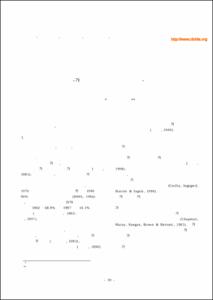모유수유교육과 추후간호방법이 산모의 모유수유실천율과 모유수유방법에 미치는 효과 - 가정방문과 전화상담을 중심으로 -
- Affiliated Author(s)
- 고효정
- Alternative Author(s)
- Koh, Hyo Jung
- Journal Title
- 여성건강간호학회지
- ISSN
- 1225-9543
- Issued Date
- 2001
- Abstract
- This was a pre-experimental
study to confirm the breast-feeding ability and effect of follow up care on the breast-feeding rate and the breast-feeding method by the mother-infant breast-feeding assessment tool for the mothers who got the breast-feeding education. The subjects were 46 mothers who experienced normal delivery of infants at a college hospital in K-city, Kyungsangbuk-do, from July 1 to October 21, 2000. The instrument for data obtainment were The Mother-Infant Breast-Feeding Assessment Tool of Johnson et al. (1999), and The Breast- Feeding Method Measurement Tool of Jeong, Geum-hee(1997). This instrument was reliable, showing Cronbach α.751. This study classified them into 3 groups: at high risk for breast-feeding failure, at risk for breast-feeding problems, and at low risk for breast-feeding failure by the mother-infant breast-feeding assessment tool on the day of discharge from the hospital after delivering individual breast-feeding education to the subjects. This study investigated the breast-feeding rate and the breast-feeding method through mail questionnaire at the four week after childbirth, and through the phone counselling and the home visit for follow up care at the first week and the second week after childbirth. The sixth week after childbirth, this study investigated the breast-feeding rate by phone. The data analyzed the hypothesizes by x2-test, paired t-test, ANOVA, Wilcoxon signed rank test, Wilcoxon rank sum test and trend analysis using SPSS/PC+ WIN 10.0 program. The results were as follows : 1) Hypothesis 1-1, "there won't be any difference the breast-feeding rate of a group at risk for breast-feeding failure by the time elapsed" was supported through constant the breast-feeding rate, because changes in the breast-feeding rate by the time elapsed after childbirth wasn't statistically significant(t= -1.501, p=.270). Hypothesis 1-2, "there won't be any difference the breast-feeding rate of group at low risk for breast-feeding failure by the time elapsed" was supported through constant the breast-feeding rate, because changes in the breast-feeding rate by the time elapsed after childbirth wasn't statistically significant(t=-1.732, p=.225). 2) Hypothesis 2-1, "there won't be any difference between the breast-feeding method of group at risk for breast-feeding failure for four weeks after childbirth and just after childbirth” was rejected, because the mean point of post test appeared to be higher than that of pre test(t=-7.267, p=.000). Hypothesis 2-2, "there won't be any difference between the breast-feeding method of the group at low risk for breast-feeding failure for four weeks after childbirth and just after childbirth" was rejected, because the mean point of post test appeared to be higher than that of pre test(t=-2.501, p=.012). 3)The 3rd hypothesis, "there won't be any difference between breast-feeding method of groups at risk for breast-feeding problems and at low risk for breast-feeding failure at the 4th week after childbirth and just after childbirth" didn't show any difference between the breast-feeding method of groups at risk for breast-feeding problems and at low risk for breast-feeding failure in the advance test(t=-1.521, p=.130) but there was difference between them in post test (t=-2.012, p=.044). As a result, the 3rd hypothesis was supported by pre test, but it was rejected by post test. In conclusion, this study confirmed breast- feeding education and follow up care just after childbirth were effective for the breast-feeding rate and method. Accordingly, it is proposed that successful nursing intervention of breast-feeding to be necessary by continuously providing follow up care through the mother-infant breast-feeding assessment tool as well as to execute individual breast-feeding education to mothers just after childbirth.
- Alternative Title
- Effect of Breast-feeding Education and Follow-up care on the Breast-feeding Rate and the Breast-feeding Method - Focused on Home Visit and Phone Counselling -
- Department
- Dept. of Nursing (간호학)
- Publisher
- College of Nursing
- Citation
- 박숙희 and 고효정. (2001). 모유수유교육과 추후간호방법이 산모의 모유수유실천율과 모유수유방법에 미치는 효과 - 가정방문과 전화상담을 중심으로 -. 여성건강간호학회지, 7(1), 30–43.
- Type
- Article
- ISSN
- 1225-9543
- Appears in Collections:
- 2. College of Nursing (간호대학) > Dept. of Nursing (간호학)
- 파일 목록
-
-
Download
 oak-bbb-4779.pdf
기타 데이터 / 171.71 kB / Adobe PDF
oak-bbb-4779.pdf
기타 데이터 / 171.71 kB / Adobe PDF
-
Items in Repository are protected by copyright, with all rights reserved, unless otherwise indicated.